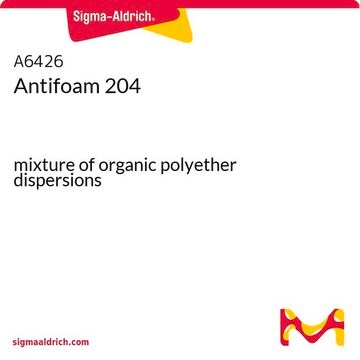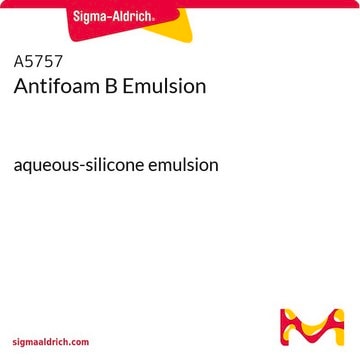A6582
Antifoam A concentrate
active silicone polymer 100%
Synonyme(s) :
Antifoam agent, Antifoam solution, Foam control agent
About This Item
Produits recommandés
Niveau de qualité
Forme
emulsion (aqueous)
Technique(s)
cell culture | hybridoma: suitable
microbiological culture: suitable
Densité
0.97 g/mL at 25 °C
Application(s)
microbiology
Température de stockage
room temp
Adéquation
(Mammalian (suspension))
bacteria (fermentation)
Description générale
Application
- in bioreactor culture for Staphylococcal enterotoxin C (SEC) production.
- to prevent foam formation during the aerobic treatment of sludge.
- to study the impact of surface tension on bioaerosol generation during bubbling.
Caractéristiques et avantages
- Molecular biology grade and tested for use in bacterial fermentation.
- Extremely effective foam suppressor for aqueous and non-aqueous systems.
- Made of 100% active silicone polymer, free of emulsifiers.
- Typically, effective at 1-100 ppm.
- Product will be stable in the pH range of 5 to 9.
- Can be directly added to a fermentation medium but it is not recommended that it be pumped to a fermenter on an as-needed basis.
Composants
Notes préparatoires
Produit(s) apparenté(s)
Mention d'avertissement
Warning
Mentions de danger
Conseils de prudence
Classification des risques
Aquatic Acute 1 - Aquatic Chronic 1
Code de la classe de stockage
10 - Combustible liquids
Classe de danger pour l'eau (WGK)
WGK 3
Point d'éclair (°F)
>213.8 °F - closed cup
Point d'éclair (°C)
> 101 °C - closed cup
Équipement de protection individuelle
Eyeshields, Gloves, type ABEK (EN14387) respirator filter
Certificats d'analyse (COA)
Recherchez un Certificats d'analyse (COA) en saisissant le numéro de lot du produit. Les numéros de lot figurent sur l'étiquette du produit après les mots "Lot" ou "Batch".
Déjà en possession de ce produit ?
Retrouvez la documentation relative aux produits que vous avez récemment achetés dans la Bibliothèque de documents.
Notre équipe de scientifiques dispose d'une expérience dans tous les secteurs de la recherche, notamment en sciences de la vie, science des matériaux, synthèse chimique, chromatographie, analyse et dans de nombreux autres domaines..
Contacter notre Service technique








